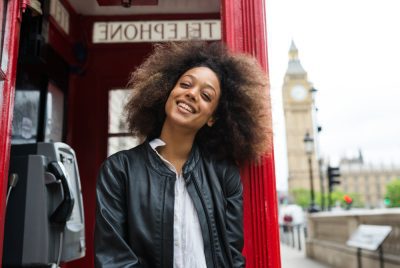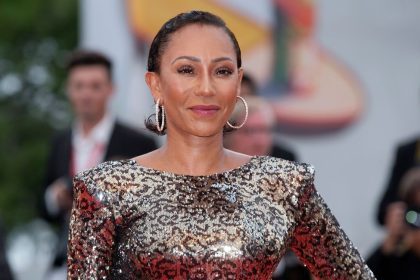
The fact that London has a distinctive Black presence should come as a surprise to no one. After all, we’re in the midst of a latter day British invasion. There’s supermodel Naomi Campbell, actors Chiwetel Ejiofor, Thandie Newton, and that magnificent hunk of maleness, Idris Elba. And who among us who came through the ’80s and ’90s can forget Sade, Soul II Soul and Floetry?
Searching out Black London on the ground takes a bit of effort. Don’t go looking for the ‘hood on Black Boy Lane, okay? It’s named for a horse, not a human being.
“Now, if you huff and puff and finally save enough money/you can take your family on a trip across the sea.”
My hidden inner black girl geek may be showing when I admit to drifting through this 2000-year-old city with British-themed melodies playing in my head. I date it to the times before I started traveling, when my exposure to the world came through books and movies and songs: “A Foggy Day in London Town”, “England Swings”, “London Bridge is Falling Down.”
“On The Street Where You Live” is quintessentially London, though the city’s name is never mentioned. It’s about that fierce, almost stalkerish delight that comes from nearing the vicinity of a loved-one’s dwelling. “And oh, the towering feeling/just to know somehow you are near.” We’ll let that song be our signpost in finding our way to some choice spots on the Black London roadmap.
Where “does enchantment pour out of every door?” When you’re in hip and happening Soho. Once a notorious red light district, this central London entertainment district is now known for its nightclubs, bars, and restaurants.
There’s traditional Caribbean fare at black-owned Jerk City on Wardour Street. While dining there I met a local celebrity, black British actor and filmmaker Frank “Scully” Prosper. The iconic Ronnie Scott’s Jazz Club is within walking distance on nearby Frith Street. All the usual suspects have performed on its stages, from Nina Simone to Chaka Khan. Recent acts include Black British sax virtuoso, Courtney Pine, Cuban and Brazilian jazz nights, James Taylor Quartet, and a celebration of the music of Charlie Parker. (Tottenham Court Road Tube station)
You may “hear a lark in any other part of town,” but you won’t find a larger concentration of blacks than in Brixton, known as the “The Harlem of London.” Brixton Road is a main drag of bustling pedestrians, department stores and coffee houses.
Heading east you hit Coldharbour Lane where Windrush Square sits across from the town hall. Named for the ship that brought Caribbean blacks to London in the late 40’s, the square is flanked by the historic Ritzy Cinema (the “it” place for black films, music shows, and performances), the Tate Free Library, and the Black Cultural Archives, a heritage center that documents the Black presence in Britain from the Roman times. You can even have a drink at the theatre bar or a snack in the museum café.
“When you look at me, what do you see/do you understand my story?” The community-trust efforts of cultural activist Jak “Nubian Jak” Beula-Dodd will soon bring Britain’s first African and Caribbean War Memorial to Windrush Square. He’s currently raising funds through a GoFundMe campaign and “We Are the World”-type cover of Eric Roberson’s “I Have a Song.”
Backtracking toward Brixton Road you’ll turn right and “rock on through Electric Avenue,” the first street in the area to get electric lights. It’s also the title of a deceptively upbeat tune; Eddie Grant wasn’t singing about electricity, but violent riots that raged through Brixton in the 1980’s. Here you’ll find the back entrance to Brixton Village, a sprawling collection of shops, produce stalls, boutiques, and eateries offering food from around the world. (Brixton Station)
“Saw you walking/Down by Ladbroke Grove this morning.” Let’s cross the River into West London. Ladbroke Grove is the main parade route of the legendary Notting Hill Carnival (which takes place during the bank holiday in late August).
The Mau Mau Bar on Portobello Road hosts hip-hop, reggae, and R&B most nights of the week. On nearby All Saints Road, you’ll find Book and Kitchen, a warm and homey bookstore/café that hosts readings, lectures, arts exhibits, writers workshops and musical performances, yummy vegan food, books, books, and more books! “And through foggy London town the sun was shining everywhere!” (Ladbroke Grove or Westbourne Park Station)
Getting Around Black London
Take overground buses if you prefer the scenic route, the underground Tube (London’s extensive subway system) if you need to get there quickly.This year marks the first time in its 150-year history that the Tube runs 24 hours, limited for now to five lines on Friday and Saturday nights — Piccadilly, Victoria, Central, Jubilee and sections of the Northern Line. If you’re keeping late hours other days of the week, or traveling on any of the other seven subway lines, you’ll have to return from your revels on a night bus, taxi, or a fixed price minicab. There are also several light rails (though most service ends at midnight) and an extensive system of buses, both single- and double decker.
For convenience, an Oyster Card can be preloaded with pay-as-you-go credit, or purchased as a travelcard for unlimited rides on most of London’s transport system; student and child discounts are available.
Sandra Jackson-Opoku is the author of the award-winning novel THE RIVER WHERE BLOOD IS BORN and the critically-acclaimed HOT JOHNNY (AND THE WOMEN WHO LOVED HIM).



















